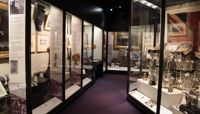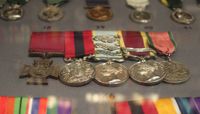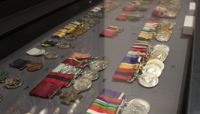A statement about items in the Essex Regiment Collection
Update: The missing Victoria Crosses have been returned to Chelmsford Museum. Please read the latest news here.
In late 2023, a routine inspection of items in the Essex Regiment Museum collection, housed at Chelmsford Museum, discovered that two of its Victoria Crosses could not be found. It is not unusual for museums and galleries to possess replicas of valuable artefacts, and replicas of these VCs were located, but not the original medals awarded to Sergeant William McWheeney in 1857 and Lieutenant Francis Parsons posthumously in 1900.
The museum immediately informed the Essex Regiment Museum and began a search for the originals. A report was also made to Essex Police. There is currently no evidence to suggest that the original crosses have been stolen, but Chelmsford Museum remains in regular contact with the police and will pass on any further information that comes to light as part of its search. The descendants of those awarded the medals have also been contacted. The replica medals are currently on public display in Chelmsford Museum.
Since the discovery, curators have conducted a fingertip search of the Essex Regiment Museum collection and continued to search for the original crosses as they carry out work on a long-term collections management project. The project, which began during the museum’s first lockdown closure in 2020, aims to improve documentation of Essex Regiment Museum and Chelmsford Museum’s combined collections of around 100,000 objects.
With relatively large collections for museums of their size and a small team of curators, this project will take some time. Until this is completed, or unless new information becomes available, the museum cannot confirm whether the medals have been lost or are simply located elsewhere within the collections.
Museum collections are constantly moving as part of normal day-to-day activities and, with large numbers of items acquired over many decades, objects may occasionally be unaccounted for or sometimes found in a different location to that recorded. This is a common challenge that many museums are currently facing, and can be due to data transfer faults, delays in processing large numbers of items, or human error.
Marc De’ath, Chelmsford City Culture Services Manager said:
“We understand that many people will be worried about this news, which is a concern shared by the team at Chelmsford Museum. We are determined to do everything in our power to recover the crosses; our curatorial staff have been working hard to search for them and this work will continue for as long as it takes. Although there will inevitably be some speculation about this news, I would urge people not to jump to conclusions. At this stage, we are keeping an open mind about what has happened; there is currently no evidence to suggest that these medals have been stolen and staff at the museum are not under suspicion.
“Work to improve management of the museum’s collections is a key priority. It is slow, painstaking work that we want to make sure we do properly, and this will take some time for our small team to complete. We will work closely with the Essex Regiment Museum and Essex Police as we continue our search, and we would urge anyone with information that may be relevant to get in touch with the police.”
Marc De’ath, Chelmsford City Culture Services Manager







